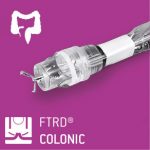gastroduodenal FTRD®: a valuable option for large duodenal neuroendocrine tumors
EFTR with the gastroduodenal FTRD: a valuable option for the treatment of large duodenal neuroendocrine tumors
A retrospective study evaluated the feasibility and safety of exposed (resection similar to ESD) and nonexposed (device-assisted using the gastroduodenal FTRD System) EFTR in 20 patients with large duodenal subepithelial lesions (≥10 mm). Technical success rates for exposed and nonexposed techniques were 100% and 78%, respectively. Endoscopic complete resection was achieved in all patients with R0 resection in 76.9% of cases (exposed EFTR) and 85.7% (device-assisted EFTR). Three adverse events occurred, including two cases of leaks after exposed EFTR.
Nabi et al. analyzed data from patients who underwent EFTR for duodenal subepithelial lesions, using both exposed and nonexposed (device-assisted) approaches. The primary outcome was the technical success of EFTR in the duodenum (defined as complete endoscopic resection of the lesion (en bloc or piecemeal) with no endoscopically visible residual tumor), with secondary outcomes including adverse events, R0 resection (defined as the absence of vertical and lateral margin involvement in the histopathologic evaluation), and recurrence at follow-up.
During the study period, EFTR was performed in twenty patients (17 men; mean age of 55.9±9.1 years) with duodenal subepithelial lesions (mean size of 14.2±3.6 mm). Of these, 11 patients underwent exposed EFTR, while 9 received the nonexposed technique. Most lesions were duodenal neuroendocrine tumors of grade I/II (18/20) and located in the first part of the duodenum. The mean procedure duration was 70.3±46.5 minutes (exposed EFTR 92.3±40.8 minutes; nonexposed EFTR 23.3±8.8 minutes). Technical success rates for exposed and nonexposed techniques were 100% (11/11) and 78% (7/9), respectively. The two technical failures in the nonexposed group were mainly attributed to difficult location (juxtapyloric) and large size (20 mm) of the lesion, respectively. Overall, histologic complete resection (R0) was achieved in 15 patients (75%), including exposed EFTR in 10 (76.9%) and device-assisted EFTR in 6 (85.7%). Three patients (3/20; 15%) experienced moderate to severe adverse events, including two cases of leak (after exposed EFTR; patients were managed conservatively but required prolonged hospital stays of 8 and 11 days) and one case of partial lumen obstruction (after device-assisted EFTR; patient improved with conservative management).
In conclusion, this study demonstrates that EFTR is a feasible approach for managing large duodenal subepithelial lesions, offering a reasonable safety profile. Furthermore, EFTR is effective in achieving complete resection in the majority of duodenal subepithelial lesions. These findings suggest that EFTR could be considered as a valuable option for the treatment of such lesions in clinical practice.
Nabi Z, Basha J, Inavolu P, Sayyed M, Ramchandani M, Goud R, Darisetty S, Kotla R, Reddy DN. Exposed versus nonexposed endoscopic full-thickness resection for duodenal subepithelial lesions: a tertiary care center experience (with videos). IGIE. 2023;2:154-160.e2. doi: 10.1016/j.igie.2023.04.004.
 |
 |


 Deutsch
Deutsch  Français
Français 